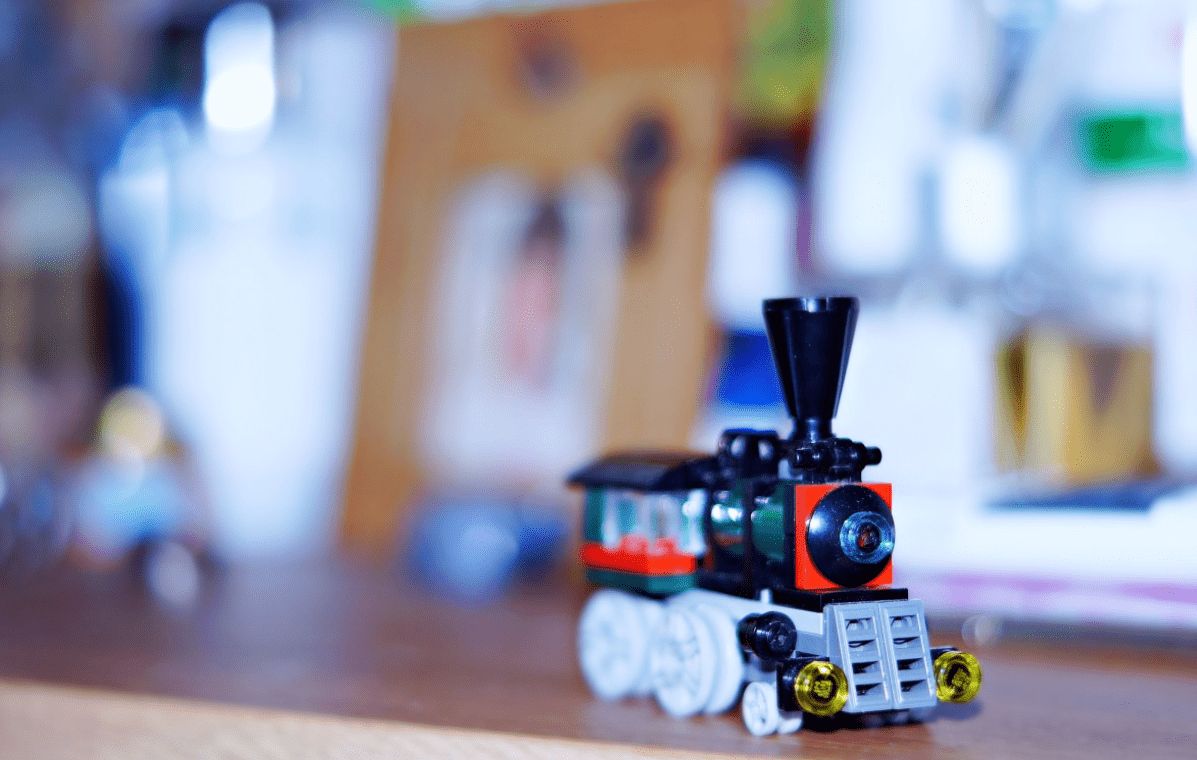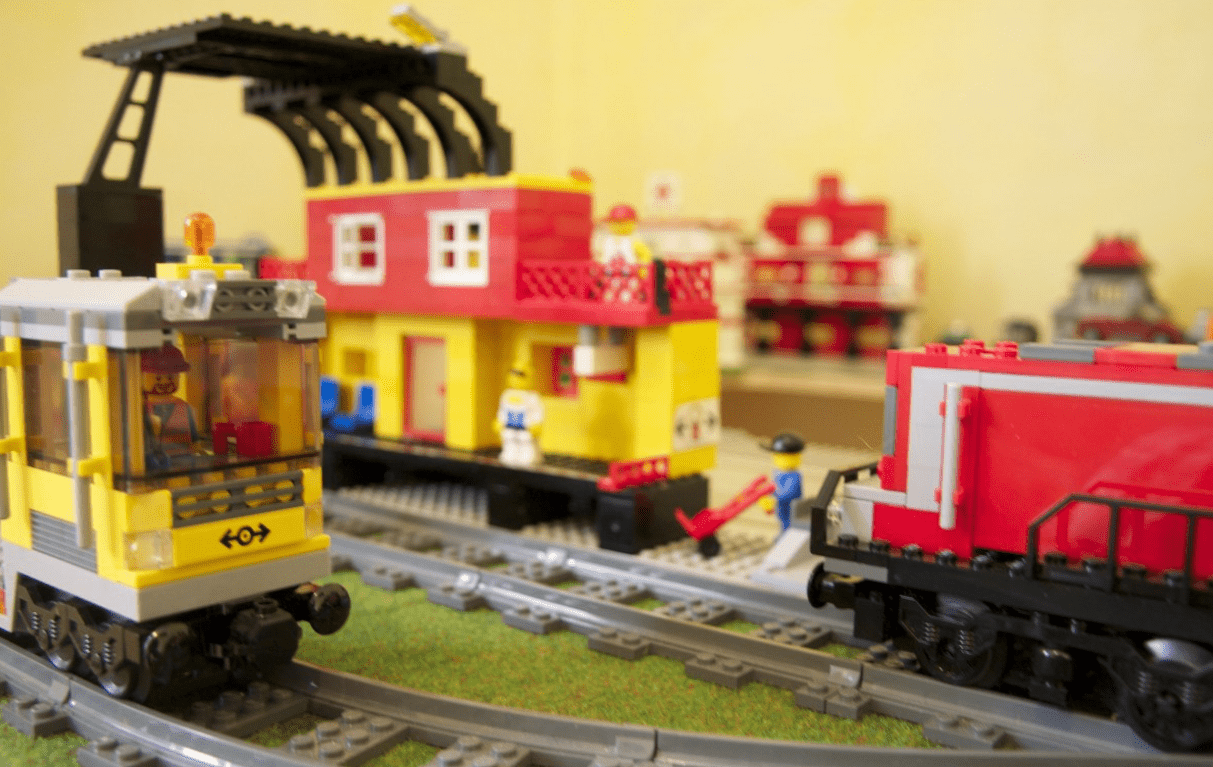Lego trains: a beloved pastime for enthusiasts, and a source of joy for everyone else. Who knew that combining plastic bricks and miniature locomotives could be so captivating? And for those new to the concept, know that Lego model railroads offer endless possibilities for fun and creativity.
In this article, we’ll take you on a journey through the whimsical realm of Lego trains, including building simple models, creating elaborate masterpieces, and more. If you’ve been looking to add a unique element to your train modeling hobby, this might just be the experience you need.
Getting Started with Lego Trains
Getting started with Lego trains might seem overwhelming, but it doesn’t have to be. Here are the basic steps to help you get started:
- Decide on a scale and track system for the train.
- Select a train set or build your own model railway.
- Set up your track and train.
- Customize your Lego train as desired.
When it comes to Lego train sets, there are different types available to suit different needs. Here are the most common types:
| Type | Description |
| Starter Sets | Include a locomotive, track, and cars. It’s ideal for those starting out. |
| Power Functions | Sets that include a battery box, remote control and motor to power your train. |
| Custom Builds | Build your train from scratch using individual parts or instructions from Lego fan communities. |
| Powered Up | Just like power functions but newer and with the option to your train with a smartphone app. |
Lego trains come in different scales that determine the size of the train and track. Here are the most common scales and track systems used in Lego model railroads:
| Scale | Track Width | Description |
| 4 Stud | 32 mm | The smallest scale, typically used for tight spaces and micro builds. s. |
| 6 Stud | 48 mm | A renowned scale used for beginner sets and small layouts. |
| 8 Stud | 64 mm | A scale dedicated to more detailed models and larger layouts. |
| 9V | 69.5 mm | An older track system featuring metal rails that you can power with y electricity. |
| RC | 72 mm | A plastic rails track system that can be powered by remote control. |
| Powered Up | 48 mm | A modern track system relying Bluetooth technology to control and power trains. |
Now that you know the basics of Lego trains, it’s time to build your layout.
Building Your Layout
When it comes to building a Lego train layout, you’ll need to consider a few things before touching any piece of the model railway.
Firstly, you’ll have to decide on the size and shape that will work best for your space. Think about the size and shape that will work best for your space. For example, if you have a small room, you might want to go for a circular layout. If you’re lucky enough to have a large space, you can get really creative with the shape.
After the size and shape, consider the scale of track and trains. You don’t want to end up with a Hogwarts Express that’s too big for your track, do you? Choose your scale wisely and create a track plan that fits your needs. Although mor advanced builders can get fancy with switches and junctions, a simple look will work just fine for beginners.
As for wiring and operating your trains using controllers and Lego motors, keep the following things in mind:
- Use insulated wire to connect your power source to your tracks
- Attach motor to your locomotive to power your train
- Install a speed controller to regulate the speed of your train
- Use a remote control to operate your train from a distance
Overall, building a Lego train layout can be a fun experience. With attention to detail, you can create a beautiful and functional layout that will provide hours of entertainment.
Customizing Your Trains and Accessories
Customizing your Lego trains and accessories is an easy way to stand out from other Lego train modelers sets. Whether it’s building custom train cars or integrating Lego trains into your existing rail models, there are plenty of ways to to make you collection pop.
Having Customized Trains and Train cars
Want a simple way to customize your Lego trains? Consider building custom train cars. Although a wide variety of train car designs are offered by Lego, building your own custom cars will add a personal touch to your collection.
Start by deciding on the design and style of the car. You can create your own unique design, or take inspiration from on reference books and online resources. Once you have a plan ready, gather the necessary bricks and start building. Don’t forget size and weight of the car, as well as the type of wheels and axles required to ensure it runs smoothly.
Accessories and Scenes
Creating unique scenery and accessories is also an excellent way to customize your Lego train sets. From buildings to trees and landscapes, there are a variety of things you can add to stand out.
To create custom scenery, plan the design and layout. Consider the environment you want to create, (cityscape? Countryside? Something else?), and then start building by collecting bricks. Other Lego accessories, such as minifigures, can help add even more personality to your scenery. If you are looking for a particular set to add to your Lego Trains creation, you can check out the Lego City Town Center.
Adding Lego Trains to Your Current Collections
You also have the option to incorporate Lego trains into your existing collection. This can be done in a few ways, one being that you build train station or depot to house your trains. Another option is to use the tracks to create a custom layout that weaves through your other Lego sets.
Want more ideas? Consider combining Lego trains with other Lego vehicles like boats, cars, and plans. This can create a more dynamic and immersive experience, as you and onlookers can imagine all sorts of scenarios and adventures. Here’s a breakdown of the common tools and materials used to customize Lego trains:
| Tool or Material | Description |
| Lego Bricks | The building blocks of any Lego creation. |
| Wheels and Axles | Crucial for building train cars that can run on tracks. |
| Reference Materials | Online resources or books for design ideas. |
| Minifigures | Can be used to add detail and personality to custom scenery. |
These elements will help make your trains one-of-a-kind . Just make sure to plan carefully and gather high-quality materials so you can have the best set among the collectors.
Advanced Techniques and Ideas
Want to improve your Lego train layout even further? Then consider familiarizing yourself with advanced techniques and ideas. These are higher-level methods you can use to create more complex and realistic designs. To get started, consider incorporating the following into your layout.
S-Curve tracks: Instead of using straight tracks, use S-curve tracks on the layout. What this does is create a more dynamic and interesting design, one that mimics the blends and curves of actual train tracks.
Lighting and Sound Effects: Adding lighting and sound effects to your train layout is a recipe for success. Consider things like streetlights, traffic signals and engine sounds to create a more immersive experience. Also see tips for adding music to your train set, if you’re interested.
Train Control Systems: Investing in a train control system can help extend the functionality of your layout. With these systems, you can modify train speeds, control train signals and switches, and even control multiple locomotives at once.
Creative Lego Train Layouts and Accessories
| Layout or Accessory | Description |
| Lego City Train Station | This multi-level train station comes with a variety of details, including a platform with waiting passengers, coffee shop and a ticket booth. |
| Lego Train Trestle Bridge | This impressive trestle bridge spans a wide river, complete with realistic water and rock details. |
| Lego Winter Village Train | This festive train features Christmas tree, and snow plow, and a gingerbread house on one of the train cars’ back. |
| Lego Train Robbery Scene | This is a Western-themed layout witha train stopped in the middle of the desert. Plus, there are a group of bandits attempting to rob the train. |
| Lego Train Turntable | With this mechanical turntable, trains can switch tracks and change directions quickly, adding even more uniqueness to your train layout. |
Resources for Lego Train Enthusiasts
Lego train enthusiasts can use a variety of resources to upskill and take their hobby to the next level. Here are some to help get you started:
Books
Lego Trains: Ideas and Instructions for Realistic Lego Train Designs: Featuring step-by-step instructions for building a variety of different trains, this book is packed with valuable insights on building a railway model that’s hard for even non-modelers to ignore.
The Lego Trains Book: This book serves as a detailed guide for building and customizing Lego trains. Find tips on realistic train car and engines, designing custom layouts, and more.
Websites and Forums
Eurobricks Train Tech Forum: Find discussions on building techniques, custom Lego train layouts and more. You can also get information about train shows happening in your area so you can attend events to connect with other hobbyists.
Brickset.com: This website includes a database of Lego sets, including train sets. Here, user reviews and ratings can help you decide which sets are worth the investment.
Local Hobby Stores and Lego User Groups
Lego User Groups: Join a local Lego user group to connect with other Lego train enthusiasts in your area. These groups provide a supportive community for sharing advice and tips on building and customizing Lego train sets.
Local Hobby Stores: Want to get more involved in your hobby? Visit your local hobby store to find a variety of Lego train sets and accessories, as well as other tools materials you might need for your layouts.
Conclusion
As you can see, the world of Lego trains is filled with countless opportunities for enthusiasts to showcase their creativity and imagination. By using basic skills coupled with advanced techniques and utilizing available resources, you a can design unique and realistic train layouts that reflect your their personal interests and styles. Plus, the availability of books and educational resources means anyone can build a Lego model railway they will be proud of. Overall, the Lego train hobby offers something for everyone to enjoy and create.

